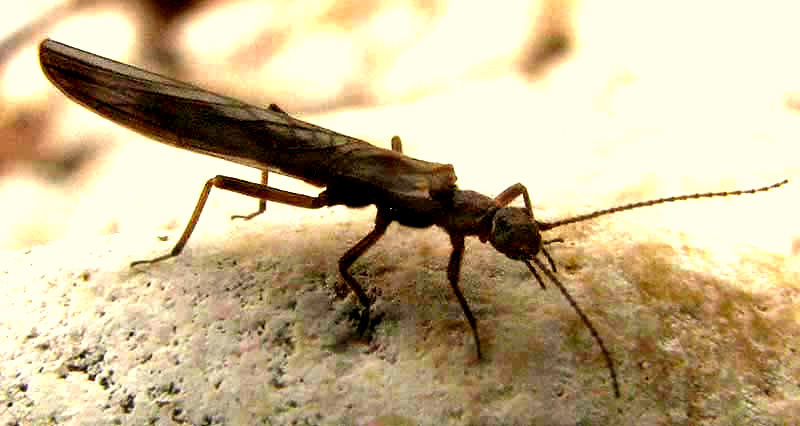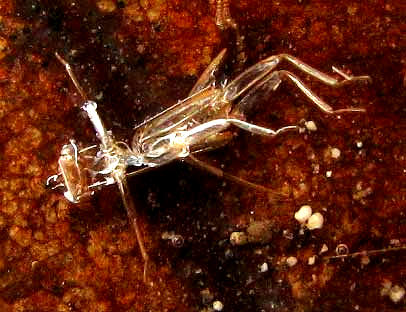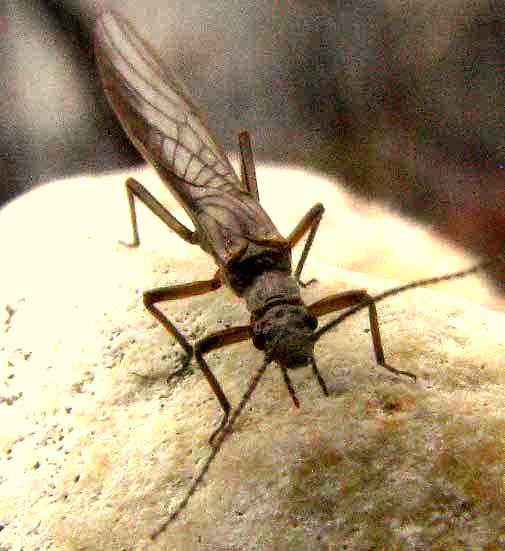Excerpts from Jim Conrad's
Naturalist Newsletter

from the January 5, 2014 Newsletter issued from the Frio Canyon Nature Education Center in the valley of the Dry Frio River in northern Uvalde County, southwestern Texas, on the southern border of the Edwards Plateau; elevation ~1750m (~5750 ft); N29.62°, W99.86°; USA
STONEFLIES
Here in early winter I was surprised to find floating on the water's surface at the edge of the Dry Frio the freshly discarded "skin," or exuvia, of an aquatic insect nymph after it had just metamorphosed into a winged adult. That's it below:

The exuvia was only about half an inch long (13mm) so it was too small to have been left behind by an emerging dragonfly or mayfly. After looking around awhile a small, winged insect turned up atop a limestone cobblestone seeming to be basking in the morning sunlight, and maybe drying his wings after his recent departure from the water. He perched with his rear end curiously angled higher than his head, as shown at the top of this page.
It was surprising that my picture taking didn't cause the creature to fly away. Maybe he was too cold or his wings were not hardened enough after his recent metamorphosis. Whatever the cause, with such a cooperative subject I had to take a closer shot of the head, shown below:

With that thick, neck-like section behind the head, the pronotum, it looked like a dobsonfly or fish fly, but they're larger. After browsing Internet pictures searching on the keywords "freshwater insects," a match turned up. We have a stonefly, of the Order Plecoptera. If you spend much time turning over rocks in unpolluted streams you've seen lots of stonefly nymphs (technically known as "naiads"), which are easy to identify because to help them cling to their submerged rock in flowing water they are flattish. They also bear two hairlike tails, or cerci, at their rear ends. If I'd been willing to capture our subject on the rock and forcibly spread apart his wings, I'd have found that his rear end also bore two cerci.
Though I've seen thousands of stonefly nymphs I've always wondered what the adult looked like. One reason stonefly adults are less well known than their aquatic nymphs is that stonefly nymphs survive for one to four years, depending on the species -- undergoing 12 to 33 molts before emerging as terrestrial adults -- while the adults generally survive only for a few weeks, and emerge only during specific seasons. Some adults don't feed at all. Those that do feed are herbivorous.
About 28 stonefly species are listed for Texas, but identifying them to species or even genus requires more probing and dissection than I'm willing to do.
Stoneflies lack any spectacular or specialized anatomical parts. Their mouthparts are simple with chewing mandibles and their antennae are long and multiple-segmented antennae. They possess two large compound eyes and two or three ocelli, which are tiny simple eyes on the head between the compound eyes. One reason stoneflies lack special features is that they are believed to be of a primitive lineage, having close relatives identified from the Carboniferous and Lower Permian -- over 300 million years ago. In other words, their basic design was established before Nature came up with such useful concepts as the butterfly's coiled proboscis or the stag beetles oversized pincers.
Stoneflies are intolerant of water pollution, so their presence in the Dry Frio indicates that our river water is in pretty good shape.